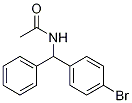N-[(4-BroMophenyl)(phenyl)Methyl]acetaMide CAS#: 5580-51-8; ChemWhat Code: 787340
Identification
| Patent Information | ||
| Patent ID | Title | Publication Date |
| CN117069555 | Synthesis method of substituted phenol | 2023 |
| WO2015/7615 | PHENYL CARBAMATES AND THEIR USE AS INHIBITORS OF THE FATTY ACID AMIDE HYDROLASE (FAAH) ENZYME AND MODULATORS OF THE D3 DOPAMINE RECEPTOR (D3DR) | 2015 |
| WO2005/90330 | N-PIPERIDINE DERIVATES AS CCR3 MODULATORS | 2005 |
| US2003/191349 | Process for the preparation of phenylphenol compounds | 2003 |
| US2003/191312 | Kinase inhibitor scaffolds and methods for their preparation | 2003 |
| US6335327 | Benzoheterocyclic derivatives | 2002 |
Physical Data
| Appearance | Light brown or white powder |
| Melting Point, °C |
| 75 – 77 |
| 74 – 75 |
| 75 – 80 |
| 77 – 78 |
| 77 |
| 80 |
| 164 – 165 |
| Description (Association (MCS)) | Solvent (Association (MCS)) | Comment (Adsorption (MCS)) | Partner (Association (MCS)) |
| Further physical properties of the adsorbed molecule | methanol, H2O | Ratio of solvents: 3:2 v/v | Zorbax CN |
Spectra
| Description (NMR Spectroscopy) | Nucleus (NMR Spectroscopy) | Solvents (NMR Spectroscopy) | Frequency (NMR Spectroscopy), MHz |
| Chemical shifts, Spectrum | 1H | dimethylsulfoxide-d6 | 400 |
| Chemical shifts, Spectrum | 1H | chloroform-d1 | 400 |
| Chemical shifts, Spectrum | 13C | chloroform-d1 | 100.6 |
| Chemical shifts, Spectrum | 13C | chloroform-d1 | 101 |
| Chemical shifts, Spectrum | 13C | dimethylsulfoxide-d6 | 101 |
| Chemical shifts, Spectrum | 1H | chloroform-d1 | |
| Chemical shifts, Spectrum | 13C | chloroform-d1 |
| Description (IR Spectroscopy) | Solvent (IR Spectroscopy) |
| ATR (attenuated total reflectance), Bands | |
| Bands | neat liquid |
| ATR (attenuated total reflectance), Intensity of IR bands, Bands | |
| ATR (attenuated total reflectance), Bands | |
| Spectrum |
| Description (UV/VIS Spectroscopy) | Solvent (UV/VIS Spectroscopy) | Absorption Maxima (UV/VIS), nm |
| UV/VIS | ||
| Absorption maxima | cyclohexane | 249, 281, 290 |
| Absorption maxima | aq. HCl | 250 |
| Absorption maxima | aq. NaOH | 305 |
| Spectrum | ethanol |
Route of Synthesis (ROS)
| Conditions | Yield |
| With hydrogen bromide; oxygen; copper(ll) bromide In 1,4-dioxane; water at 20℃; for 20h; Time; Sealed tube; | 99% |
| With tetrakis(acetonitrile)palladium(II) bis(tetrafluoroborate); 6,6′-dimethyl-2,2′-bipyridine; sodium anthraquinone-2-sulfonate; oxygen In water; dimethyl sulfoxide at 80℃; under 760.051 Torr; for 48h; | 93% |
| With iodine; dimethyl sulfoxide In nitromethane at 100℃; for 24h; Reagent/catalyst; Solvent; Sealed tube; Green chemistry; | 92% |
Safety and Hazards
| Pictogram(s) |  |
| Signal | Warning |
| GHS Hazard Statements | H315 (100%): Causes skin irritation [Warning Skin corrosion/irritation] H319 (100%): Causes serious eye irritation [Warning Serious eye damage/eye irritation] H335 (97.7%): May cause respiratory irritation [Warning Specific target organ toxicity, single exposure; Respiratory tract irritation] |
| Precautionary Statement Codes | P261, P264, P264+P265, P271, P280, P302+P352, P304+P340, P305+P351+P338, P319, P321, P332+P317, P337+P317, P362+P364, P403+P233, P405, and P501 |
Other Data
| Transportation | Under room temperature away from light |
| HS Code | |
| Storage | Under the room temperature and away from light |
| Shelf Life | 2 years |
| Market Price |
| Druglikeness | |
| Lipinski rules component | |
| Molecular Weight | 170.211 |
| logP | 3.556 |
| HBA | 0 |
| HBD | 1 |
| Matching Lipinski Rules | 4 |
| Veber rules component | |
| Polar Surface Area (PSA) | 20.23 |
| Rotatable Bond (RotB) | 1 |
| Matching Veber Rules | 2 |
Buy Reagent | |
| No reagent supplier? | Send quick inquiry to ChemWhat |
| Want to be listed here as a reagent supplier? (Paid service) | Click here to contact ChemWhat |
Approved Manufacturers | |
| Want to be listed as an approved manufacturer (Requires approvement)? | Please download and fill out this form and send back to approved-manufacturers@chemwhat.com |
Other Suppliers | |
| Watson International Limited | Visit Watson Official Website |
Contact Us for Other Help | |
| Contact us for other information or services | Click here to contact ChemWhat |



![Route of Synthesis (ROS) of N-[(4-BroMophenyl)(phenyl)Methyl]acetaMide CAS 5580-51-8](https://www.chemwhat.com/wp-content/uploads/2018/03/Route-of-Synthesis-ROS-of-N-4-BroMophenylphenylMethylacetaMide-CAS-5580-51-8-3.png)